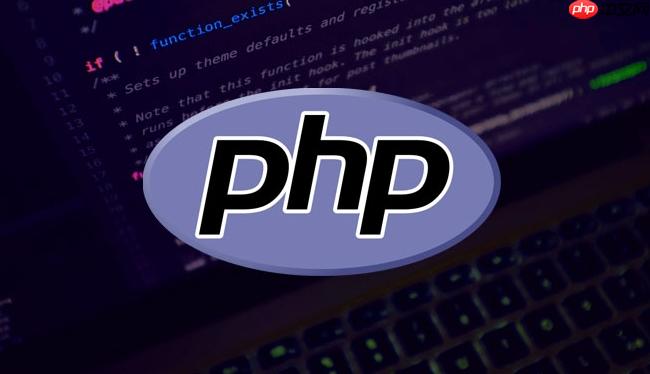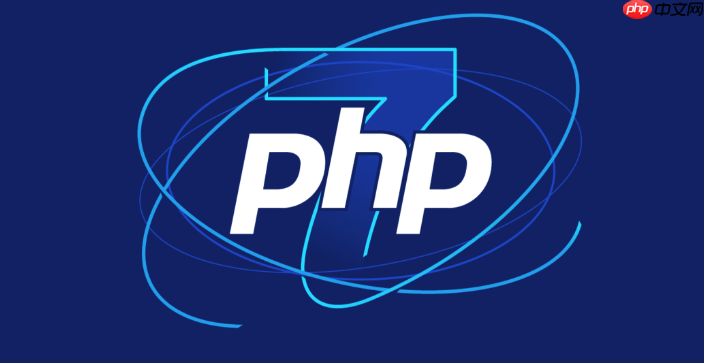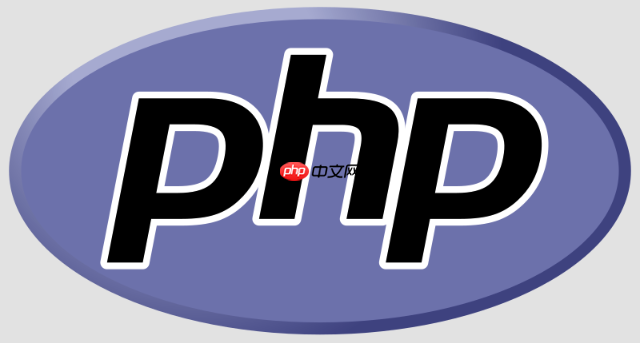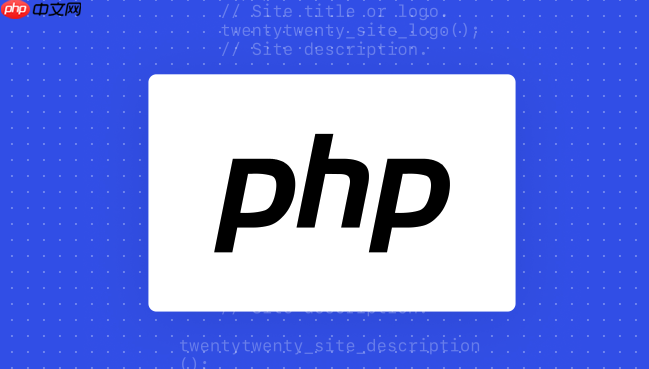 Backend Development
Backend Development
 PHP Tutorial
PHP Tutorial
 How to use Kubernetes to keep PHP environment consistent Production and local container configuration standards
How to use Kubernetes to keep PHP environment consistent Production and local container configuration standards
How to use Kubernetes to keep PHP environment consistent Production and local container configuration standards
Jul 25, 2025 pm 06:21 PMTo solve the problem of inconsistency between PHP environment and production, the core is to use Kubernetes' containerization and orchestration capabilities to achieve environmental unification. The specific steps are as follows: 1. Build a unified Docker image, including all PHP versions, extensions, dependencies and web server configurations to ensure that the same image is used in development and production; 2. Use Kubernetes' ConfigMap and Secret to manage non-sensitive and sensitive configurations, and implement different environment configurations through volume mounts or environment variable injections to achieve different environment configurations; 2. 3. Ensure application behavior consistency through unified Kubernetes deployment definition files (such as Deployment, Service) and include in version control; 4. Establish a CI/CD pipeline to achieve full process automation from construction, testing to deployment, and reduce the risks of human intervention and environmental drift; 5. Use configurations and tools consistent with production in the local Kubernetes environment, combining code volume mount, port mapping and debugging strategies to improve development efficiency and verify production compatibility in advance.

We all experienced that kind of nightmare of "can run on my machine", right? Especially for PHP, versions, extensions, and ini configurations, they will be very different if you are not careful. Kubernetes fundamentally solves the problem of PHP environment drifting between local and production. By forcing the consistency of container imagery, configuration management and resource definition, "environment consistency" is no longer a slogan, but a real engineering practice. The key is that we must standardize the construction process, make good use of K8s' configuration management capabilities, and unify the orchestration and definition.

Solution
To keep PHP environments highly consistent locally and in production, the core is to containerize the "environment" itself and to use the powerful orchestration capabilities of Kubernetes to force this consistency. This is not just about stuffing PHP applications into Docker, it is also a transformation of processes and thinking.
The first and most critical step is to build a single, authoritative Docker image . This image contains all PHP versions, extensions, Composer dependencies, and even basic web server configurations (such as Nginx or Apache) that your application needs. Both the development environment and the production environment must use this same image. This means that the containers launched locally by the developer and the containers that are eventually deployed to the production environment are exactly the same as their underlying operating system, PHP version, all extensions and their respective versions. When building the image, we will pre-install all necessary system dependencies and PHP extensions (such as pdo_mysql , redis , opcache , etc.).

Secondly, configuration management is another pillar for achieving environmental consistency. The configuration of PHP applications, such as php.ini settings, environment variables, database connection strings, cache server addresses, etc., should not be hard-coded in the mirror. Instead, we should use Kubernetes' ConfigMap and Secret to manage these configurations. ConfigMap is used for non-sensitive configurations, such as php.ini adjustments, or Nginx virtual host configurations; Secret is used for sensitive data, such as database passwords and API keys. These configurations can be injected into the container through volume mounts or environment variables. The advantage of this approach is that you can provide different ConfigMap or Secret for different environments (development, testing, production) without modifying or rebuilding the Docker image.
Next, Kubernetes deployment definition files (Deployment, Service, Ingress, etc.) are themselves an important guarantee for environmental consistency. These YAML files define how your application runs: how much CPU and memory it requires, which ports it exposes, how health checks are performed, and how they are accessed externally. By also including these definition files in version control and ensuring that local development environments (such as Minikube or Docker Desktop's Kubernetes) and production environments use the same definition files, you can ensure that the behavior patterns of applications in different environments are consistent. For example, the health check logic you tested locally is still valid in the production environment.

Finally, the CI/CD pipeline is an automated guarantee that ensures that the above strategies are implemented. When the code is submitted, the CI/CD system will automatically build the Docker image, run the tests, and then push the image to the container registry. When deployed to Kubernetes, CI/CD pulls the latest and proven image and applies a predefined Kubernetes manifest file. This ensures that the entire process from code to deployment is automated and repeatable, greatly reducing the risk of human error and environmental drift.
How to build a reusable PHP Docker image to ensure the unity of local and production environments?
Building a reusable PHP Docker image is not just as simple as writing a Dockerfile, it involves a well-thought-out strategy. My experience is that the core lies in "building at one time, running multiple places". This means that the images you build can be run on the developer's laptop and in the test environment, and ultimately seamlessly deployed to the production environment.
We usually start with an official PHP-FPM basic image, such as php:8.2-fpm-alpine or php:8.1-fpm-bullseye . The advantage of choosing an Alpine system is that the image size is small, but if you encounter some compilation dependency problems, Debian systems (such as Bullseye) may be more worry-free. This depends on your specific project and team preferences.
In the Dockerfile, I will specify the PHP version explicitly and install all necessary PHP extensions. Here is a tip: install the extensions required for both development and production environments directly. However, for tools that are only needed in the development environment (such as Xdebug, specific debugging tools), you can consider using multi-stage build. For example, one build phase is dedicated to installing Composer dependencies and test tools, and the other phase contains only the minimum set required to run the application.
# --- Stage 1: Building dependencies and development tools---
FROM php:8.2-fpm-alpine AS builder
# Install system dependency RUN apk add --no-cache \
git \
zip \
unzip \
iciu-dev \
libpq-dev \
# ... Other build dependencies # Install PHP extension RUN docker-php-ext-install pdo_mysql opcache bcmath intl exif pcntl \
&& docker-php-source delete \
# Install pecl extension&& pecl install redis \
&& docker-php-ext-enable redis
# Install Composer
COPY --from=composer:latest /usr/bin/composer /usr/local/bin/composer
WORKDIR /app
COPY composer.* ./
RUN composer install --no-dev --optimize-autoloader --no-scripts
# --- Stage 2: Final mirroring of production environment---
FROM php:8.2-fpm-alpine
# Install the necessary system dependencies for production environment RUN apk add --no-cache \
libpq \
# ...Other Runtime Dependencies# Copy PHP extensions (if required)
# Install the necessary extensions directly in the production image, or copy RUN from the builder stage docker-php-ext-install pdo_mysql opcache bcmath intl exif pcntl \
&& docker-php-source delete \
&& pecl install redis \
&& docker-php-ext-enable redis
# Copy the application code COPY --from=builder /app /app
# Set the working directory WORKDIR /app
# Expose FPM port EXPOSE 9000
# Default CMD, can be overwritten by Kubernetes Deployment ["php-fpm"] In practice, I will make sure that composer install is done during the image building process and use --no-dev and --optimize-autoloader to ensure that the production image is as small and efficient as possible. For the code, I'd copy them into the image instead of mounting at runtime, unless it's a temporary mount for quick iteration during development.
Mirror version management is also crucial. Use meaningful tags, such as my-app:1.0.0 or my-app:latest . For development branches, you can add the -dev suffix, such as my-app:feature-branch-dev . In this way, in the Kubernetes Deployment file, you only need to update the mirror tag to switch versions, which is very convenient.
How to efficiently manage the configuration and sensitive data of PHP applications in Kubernetes to avoid environmental differences?
The key to managing PHP applications' configuration and sensitive data in Kubernetes is to decouple: stripping the configuration from the mirror and making it independent of the code and runtime. This is not only for environmental consistency, but also for security and maintainability. I'm a big fan of ConfigMap and Secret .
ConfigMap is ideal for storing configurations that do not contain sensitive information, such as your php.ini custom settings, Nginx site configuration, or some application-level environment variables. You can define a ConfigMap and inject it into the pod in two main ways:
Injection as environment variable: suitable for small and simple configuration items.
apiVersion: apps/v1 kind: Deployment metadata: name: my-php-app spec: template: spec: containers: - name: php-fpm image: my-php-app:1.0.0 envFrom: - configMapRef: name: app-config --- apiVersion: v1 kind: ConfigMap metadata: name: app-config data: APP_ENV: production PHP_MEMORY_LIMIT: 256MAs file volume mount: This is the way I recommend more, especially for complex configuration files (such as full
php.inior Nginx configuration).apiVersion: apps/v1 kind: Deployment metadata: name: my-php-app spec: template: spec: containers: - name: php-fpm image: my-php-app:1.0.0 volumeMounts: - name: php-ini-volume mountPath: /usr/local/etc/php/conf.d/custom.ini # Overwrite or add php.ini configuration subPath: custom.ini - name: nginx-config-volume mountPath: /etc/nginx/conf.d/default.conf subPath: default.conf Volumes: - name: php-ini-volume configMap: name: php-custom-ini - name: nginx-config-volume configMap: name: nginx-site-config --- apiVersion: v1 kind: ConfigMap metadata: name: php-custom-ini data: custom.ini: | memory_limit = 256M upload_max_filesize = 128M post_max_size = 128M --- apiVersion: v1 kind: ConfigMap metadata: name: nginx-site-config data: default.conf: | server { listen 80; server_name _; root /app/public; index index.php index.html; location / { try_files $uri $uri/ /index.php?$query_string; } location ~ \.php$ { fastcgi_pass 127.0.0.1:9000; # or php-fpm service name fastcgi_index index.php; fastcgi_param SCRIPT_FILENAME $document_root$fastcgi_script_name; include fastcgi_params; } }
For sensitive data, Secret are used similarly to ConfigMap , but they are stored in base64 encoding inside Kubernetes (not encrypted, requiring additional tools such as Sealed Secrets or Vault for real encryption). Likewise, it can be injected via environment variables or file volume mounts.
apiVersion: apps/v1
kind: Deployment
metadata:
name: my-php-app
spec:
template:
spec:
containers:
- name: php-fpm
image: my-php-app:1.0.0
env:
- name: DB_PASSWORD
valueFrom:
secretKeyRef:
name: app-secrets
key: db_password
volumeMounts:
- name: api-key-volume
mountPath: /etc/secrets/api_key
subPath: api_key
Volumes:
- name: api-key-volume
Secret:
secretName: app-secrets
---
apiVersion: v1
kind: Secret
metadata:
name: app-secrets
type: Opaque
data:
db_password: <base64 encoded password>
api_key: <base64 encoded API key> In actual projects, we will also combine tools such as Helm or Kustomize to manage multi-environment configurations. They allow you to define a basic Kubernetes manifest template and then provide different values.yaml files or kustomization.yaml files for different environments (development, testing, production) to overwrite or merge specific values in ConfigMap and Secret . In this way, your core deployment logic remains unchanged, but the configuration changes with the environment, greatly reducing the complexity of configuration management and ensuring consistency between environments. I have seen too many projects that directly package the ini file into the mirror, and then rebuild the image every time I change the memory limit. That is simply a disaster. This decoupling method is the right way.
What strategies can be adopted to simulate production in the local Kubernetes environment and improve development efficiency?
The purpose of simulated production Kubernetes environment locally is to enable developers to run and debug code in the closest way to production, thereby reducing the problem of "can run on my machine". This is not only a technical issue, but also an optimization of the development process.
First, choosing the right local Kubernetes tool is crucial. Both Minikube and Kind are good choices, which can quickly launch a single or multi-node Kubernetes cluster on your laptop. If you use Docker Desktop, its built-in Kubernetes functionality is also powerful enough, and it is often the most convenient for most PHP application development. I personally prefer Docker Desktop K8s because it is closely integrated with the Docker ecosystem, saving you the hassle of additional installation and configuration.
The key is to use the exact same Kubernetes manifest files locally and in production environments . This means that your Deployment.yaml , Service.yaml , Ingress.yaml , ConfigMap and Secret definitions should all be the same set. Of course, for local environments, you may need to adjust some values, such as resource requests (local may not require that high CPU/memory limit), or database connections point to local MySQL containers instead of remote RDS. These differences can be achieved by the aforementioned local configuration override of Helm or Kustomize instead of modifying the core file.
In order to improve development efficiency, especially for interpreted languages like PHP, we usually do not want to rebuild Docker images every time we modify the code. Here is a small trade-off:
Volume Mounts for Code: In the development environment, you can mount the local code directory directly to the
/appdirectory of the PHP-FPM container. In this way, if you modify the local code, the code inside the container will be updated immediately without rebuilding the image or restarting the pod.apiVersion: apps/v1 kind: Deployment metadata: name: my-php-app-dev spec: template: spec: containers: - name: php-fpm image: my-php-app:latest # or a special dev image volumeMounts: - name: app-code mountPath: /app Volumes: - name: app-code hostPath: path: /Users/youruser/projects/my-php-app # Your local project path type: DirectoryNote: This method is only used for development, and the production environment must not do this. The production environment's code must be part of the mirror.
Local DNS resolution and service exposure: You may need to map the K8s internal service port to the local port through
kubectl port-forward, or configure the local/etc/hostsfile to point the Ingress domain name to the IP address of the local Kubernetes cluster. This allows you to access locally running applications through domain names or specific ports just like you would access real production services.Debugging strategy: For PHP applications, Xdebug is a necessary debugging tool. In a Kubernetes environment, you need to make sure that Xdebug is correctly connected to the debug port of your local IDE. This usually involves configuring Xdebug's
xdebug.client_hostto point to your local IP and making sure that the Pod can access this IP (may requirehost.docker.internalor your host IP). Meanwhile, Xdebug's debug port (usually 9003) is mapped from the Pod to local viakubectl port-forward.-
External service dependencies: Your PHP application may rely on MySQL, Redis, etc. Locally, you can choose:
- Deploy these services in a local K8s cluster (using their official Helm Charts or simple deployment).
- Start these services in Docker Compose, and then connect the PHP application in K8s to the services in the Docker Compose network.
- Connect directly to a database or external test service running on the local machine. Which method to choose depends on the complexity of the project and resource consumption. For simple development, it may be more convenient to connect to the local database directly.
Through these strategies, developers can perform iterative development and testing in a highly simulated production environment, significantly reducing the risk of problems being discovered only after deployment to production. It's a bit like putting on your code a "mini-version set for production environments" and you can feel whether it fits in advance locally.
The above is the detailed content of How to use Kubernetes to keep PHP environment consistent Production and local container configuration standards. For more information, please follow other related articles on the PHP Chinese website!

Hot AI Tools

Undress AI Tool
Undress images for free

Undresser.AI Undress
AI-powered app for creating realistic nude photos

AI Clothes Remover
Online AI tool for removing clothes from photos.

Clothoff.io
AI clothes remover

Video Face Swap
Swap faces in any video effortlessly with our completely free AI face swap tool!

Hot Article

Hot Tools

Notepad++7.3.1
Easy-to-use and free code editor

SublimeText3 Chinese version
Chinese version, very easy to use

Zend Studio 13.0.1
Powerful PHP integrated development environment

Dreamweaver CS6
Visual web development tools

SublimeText3 Mac version
God-level code editing software (SublimeText3)

Hot Topics
 How to use PHP combined with AI to achieve text error correction PHP syntax detection and optimization
Jul 25, 2025 pm 08:57 PM
How to use PHP combined with AI to achieve text error correction PHP syntax detection and optimization
Jul 25, 2025 pm 08:57 PM
To realize text error correction and syntax optimization with AI, you need to follow the following steps: 1. Select a suitable AI model or API, such as Baidu, Tencent API or open source NLP library; 2. Call the API through PHP's curl or Guzzle and process the return results; 3. Display error correction information in the application and allow users to choose whether to adopt it; 4. Use php-l and PHP_CodeSniffer for syntax detection and code optimization; 5. Continuously collect feedback and update the model or rules to improve the effect. When choosing AIAPI, focus on evaluating accuracy, response speed, price and support for PHP. Code optimization should follow PSR specifications, use cache reasonably, avoid circular queries, review code regularly, and use X
 PHP calls AI intelligent voice assistant PHP voice interaction system construction
Jul 25, 2025 pm 08:45 PM
PHP calls AI intelligent voice assistant PHP voice interaction system construction
Jul 25, 2025 pm 08:45 PM
User voice input is captured and sent to the PHP backend through the MediaRecorder API of the front-end JavaScript; 2. PHP saves the audio as a temporary file and calls STTAPI (such as Google or Baidu voice recognition) to convert it into text; 3. PHP sends the text to an AI service (such as OpenAIGPT) to obtain intelligent reply; 4. PHP then calls TTSAPI (such as Baidu or Google voice synthesis) to convert the reply to a voice file; 5. PHP streams the voice file back to the front-end to play, completing interaction. The entire process is dominated by PHP to ensure seamless connection between all links.
 PHP realizes commodity inventory management and monetization PHP inventory synchronization and alarm mechanism
Jul 25, 2025 pm 08:30 PM
PHP realizes commodity inventory management and monetization PHP inventory synchronization and alarm mechanism
Jul 25, 2025 pm 08:30 PM
PHP ensures inventory deduction atomicity through database transactions and FORUPDATE row locks to prevent high concurrent overselling; 2. Multi-platform inventory consistency depends on centralized management and event-driven synchronization, combining API/Webhook notifications and message queues to ensure reliable data transmission; 3. The alarm mechanism should set low inventory, zero/negative inventory, unsalable sales, replenishment cycles and abnormal fluctuations strategies in different scenarios, and select DingTalk, SMS or Email Responsible Persons according to the urgency, and the alarm information must be complete and clear to achieve business adaptation and rapid response.
 How to build a PHP Nginx environment with MacOS to configure the combination of Nginx and PHP services
Jul 25, 2025 pm 08:24 PM
How to build a PHP Nginx environment with MacOS to configure the combination of Nginx and PHP services
Jul 25, 2025 pm 08:24 PM
The core role of Homebrew in the construction of Mac environment is to simplify software installation and management. 1. Homebrew automatically handles dependencies and encapsulates complex compilation and installation processes into simple commands; 2. Provides a unified software package ecosystem to ensure the standardization of software installation location and configuration; 3. Integrates service management functions, and can easily start and stop services through brewservices; 4. Convenient software upgrade and maintenance, and improves system security and functionality.
 How to make PHP container support automatic construction? Continuously integrated CI configuration method of PHP environment
Jul 25, 2025 pm 08:54 PM
How to make PHP container support automatic construction? Continuously integrated CI configuration method of PHP environment
Jul 25, 2025 pm 08:54 PM
To enable PHP containers to support automatic construction, the core lies in configuring the continuous integration (CI) process. 1. Use Dockerfile to define the PHP environment, including basic image, extension installation, dependency management and permission settings; 2. Configure CI/CD tools such as GitLabCI, and define the build, test and deployment stages through the .gitlab-ci.yml file to achieve automatic construction, testing and deployment; 3. Integrate test frameworks such as PHPUnit to ensure that tests are automatically run after code changes; 4. Use automated deployment strategies such as Kubernetes to define deployment configuration through the deployment.yaml file; 5. Optimize Dockerfile and adopt multi-stage construction
 How to set environment variables in PHP environment Description of adding PHP running environment variables
Jul 25, 2025 pm 08:33 PM
How to set environment variables in PHP environment Description of adding PHP running environment variables
Jul 25, 2025 pm 08:33 PM
There are three main ways to set environment variables in PHP: 1. Global configuration through php.ini; 2. Passed through a web server (such as SetEnv of Apache or fastcgi_param of Nginx); 3. Use putenv() function in PHP scripts. Among them, php.ini is suitable for global and infrequently changing configurations, web server configuration is suitable for scenarios that need to be isolated, and putenv() is suitable for temporary variables. Persistence policies include configuration files (such as php.ini or web server configuration), .env files are loaded with dotenv library, and dynamic injection of variables in CI/CD processes. Security management sensitive information should be avoided hard-coded, and it is recommended to use.en
 Creating Production-Ready Docker Environments for PHP
Jul 27, 2025 am 04:32 AM
Creating Production-Ready Docker Environments for PHP
Jul 27, 2025 am 04:32 AM
Using the correct PHP basic image and configuring a secure, performance-optimized Docker environment is the key to achieving production ready. 1. Select php:8.3-fpm-alpine as the basic image to reduce the attack surface and improve performance; 2. Disable dangerous functions through custom php.ini, turn off error display, and enable Opcache and JIT to enhance security and performance; 3. Use Nginx as the reverse proxy to restrict access to sensitive files and correctly forward PHP requests to PHP-FPM; 4. Use multi-stage optimization images to remove development dependencies, and set up non-root users to run containers; 5. Optional Supervisord to manage multiple processes such as cron; 6. Verify that no sensitive information leakage before deployment
 Twilio Voice Call Maintenance and Recovery: Detailed Explanation of Meeting Mode and Independent Call Leg Processing
Jul 25, 2025 pm 08:21 PM
Twilio Voice Call Maintenance and Recovery: Detailed Explanation of Meeting Mode and Independent Call Leg Processing
Jul 25, 2025 pm 08:21 PM
This article explores in-depth two main strategies for implementing call hold (Hold) and recovery (Un-hold) in Twilio voice calls. First of all, it is recommended to use the Twilio Conference feature to easily control the retention and recovery of calls by updating the resources of meeting participants, and to configure the retention of music. Second, for more complex independent call leg scenarios, the article explains how to manage call state through carefully designed TwiML streams (such as using, and) to avoid accidental disconnection of non-holding legs and enable call reconnection.





